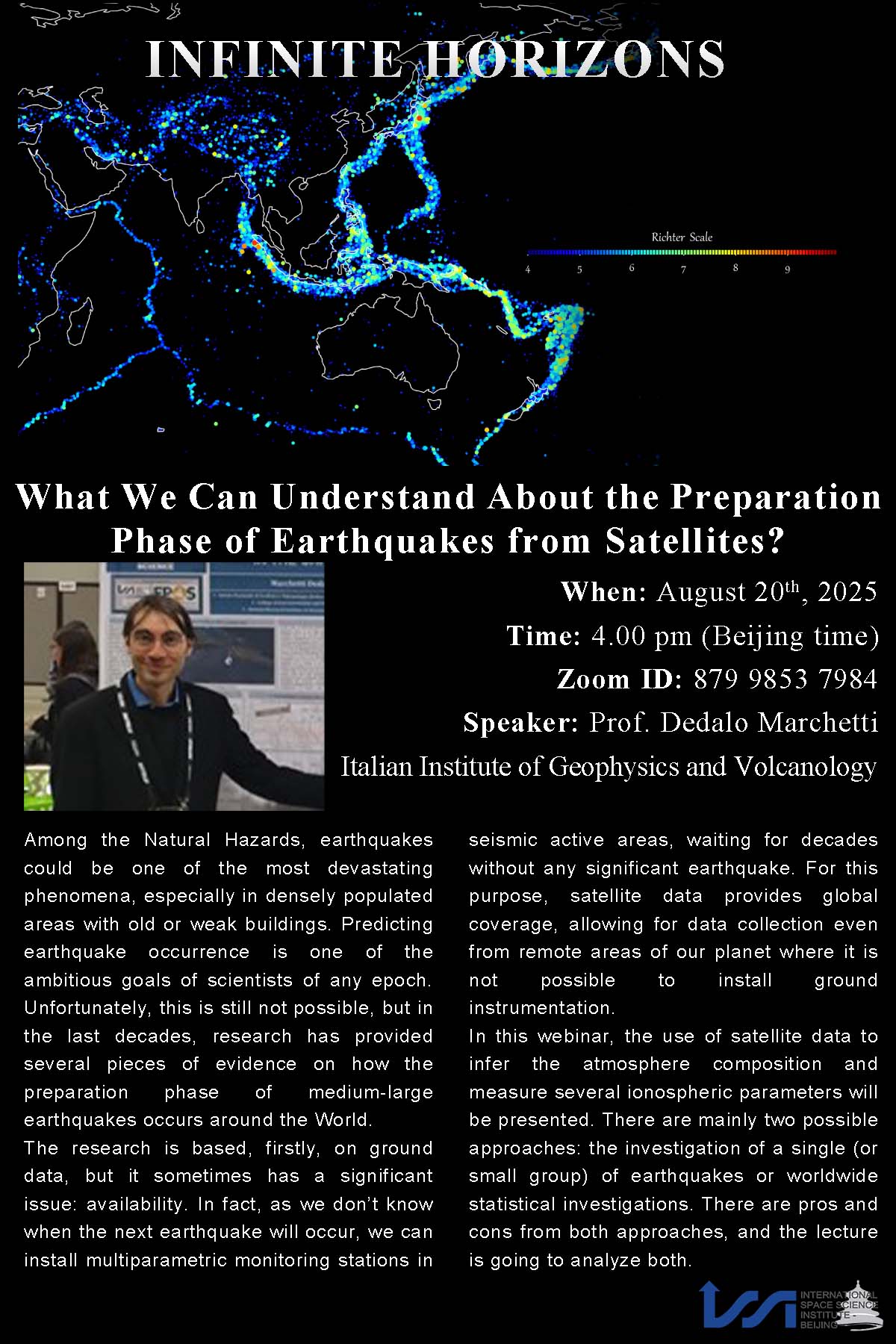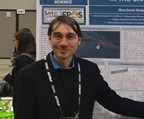Infinite Horizons: August 20th “What Can We Understand About the Preparation Phase of Earthquakes from Satellites?”
Speaker: Prof. Dedalo Marchetti (Italian National Institute of Geophysics and Volcanology, Italy)
4pm, Beijing time
Watch it on Zoom

We have the pleasure to host the next Infinite Horizons' seminar on August 20th, 2025. Our host will be Prof. Dedalo Marchetti from the Italian National Institute of Geophysics and Volcanology will talk about What Can We Understand About the Preparation Phase of Earthquakes from Satellites?
Seminar's abstract:
Among the Natural Hazards, earthquakes could be one of the most devastating phenomena, especially in densely populated areas with old or weak buildings. Predicting earthquake occurrence is one of the ambitious goals of scientists of any epoch. Unfortunately, this is still not possible, but in the last decades, research has provided several pieces of evidence on how the preparation phase of medium-large earthquakes occurs around the World.
The research is based, firstly, on ground data, but it sometimes has a significant issue: availability. In fact, as we don’t know when the next earthquake will occur, we can install multiparametric monitoring stations in seismic active areas, waiting for decades without any significant earthquake. For this purpose, satellite data provides global coverage, allowing for data collection even from remote areas of our planet where it is not possible to install ground instrumentation.
In this webinar, the use of satellite data to infer the atmosphere composition and measure several ionospheric parameters will be presented. There are mainly two possible approaches: the investigation of a single (or small group) of earthquakes or worldwide statistical investigations. There are pros and cons from both approaches. The first one, analysing a single case study, allows a detailed investigation of the plausible mechanisms of propagation of the pre-earthquake signals from lithosphere to atmosphere up to ionosphere. However, the physical link of the detected anomaly with the incoming earthquake is often hard to be supported. The second approach, i.e., the statistical investigations, provides a base to support the detected anomalies as statistically linked to the incoming earthquakes. Furthermore, it allows for calculating several parameters to assess the amount of earthquakes that are statistically preceded by one or more anomalies and how many false alarms, and so on. On the other hand, the statistical investigation lacks the details of understanding the precise mechanism due to a mix of global data.
Several interesting signals of good candidates of lithosphere-atmosphere and ionosphere coupling before earthquakes from magnitude 6.0 to 8.3 occurred in Italy, China, Chile, Indonesia, Jamaica and several other regions of the World will be shown. For statistical analyses, the magnetic and electron density data of European Space Agency (ESA) Swarm three-satellites and China Seismo Electromagnetic Satellites (CSES-01) missions will be presented. These results show that there are more anomalies detected before the earthquakes compared with a space-time uniform distribution. This supports a statistical link of the anomalies with the incoming earthquake occurrence, but still is not sufficient to be used for a prediction.
Zoom ID: 879 9853 7984
(Our Infinite Horizons seminars are usually host on the third Wednesday of the month)
About the speaker:

Dedalo Marchetti obtained a degree in astronomy and astrophysics and a PhD in Physics with a thesis centred on the measurement of the polarisation of exoplanets. Since 2016, he has been working at the Italian National Institute of Geophysics and Volcanology. The principal focus of his current research is to analyse variations in the Earth’s magnetic field in search of possible precursors of earthquakes using satellite and ground measurements. He is also developing statistical and case study analyses for research on other potential effects in the atmosphere and ionosphere prior to earthquake occurrence. From September 2018 to 2023, he worked in China as a postdoctoral fellow at Nanjing University of Information Science and Technology and in the Dingxin PostDoc Excellence program at Jilin University under the supervision of Prof. Zhu Kaiguang. In particular, he analyses the data acquired by the China Seismo Electromagnetic Satellite, which is still in orbit. He received funding from the China Postdoctoral Natural Science Foundation for developing multiparametric studies of earthquakes. In June 2023, together with Prof. Essam Ghamry, they started to lead an international team supported by International Space Science Institute (ISSI and ISSI-BJ) titled “Investigation of the Lithosphere Atmosphere Ionosphere Coupling (LAIC) Mechanism before the Natural Hazards”. From 2024, He returned to work at the Italian National Institute of Geophysics and Vulcanology.